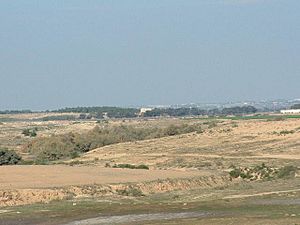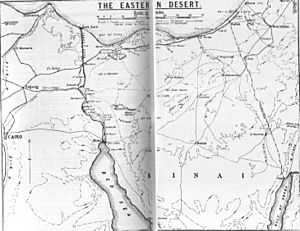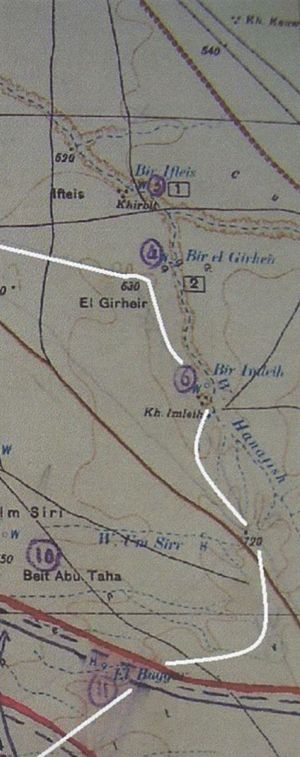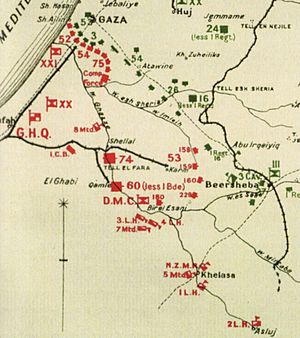Battle of Buqqar Ridge facts for kids
Quick facts for kids Battle of El Buqqar Ridge |
|||||||
|---|---|---|---|---|---|---|---|
| Part of the Middle Eastern theatre of World War I | |||||||
 El Buqqar Ridge. |
|||||||
|
|||||||
| Belligerents | |||||||
| Commanders and leaders | |||||||
| Units involved | |||||||
|
|
||||||
| Strength | |||||||
| 3 infantry brigades 2 mounted brigades |
2 infantry regiments 1 mounted division |
||||||
| Casualties and losses | |||||||
| 24 killed 53 wounded 10 missing |
10 killed 40 wounded |
||||||
The Battle of El Buqqar Ridge happened on 27 October 1917. It was a fight during World War I in Ottoman Palestine. Ottoman and German forces attacked British troops. This battle took place during the last days of a long standstill in Southern Palestine.
The Ottoman commander ordered a strong scouting mission. This mission had many more soldiers than the British Yeomanry (a type of cavalry) holding the outpost line. One British group had to pull back a little. But they held their ground until help arrived. Then the attackers left. However, another group of Yeomanry soldiers was surrounded and killed.
Just four days later, the British launched a major attack. This attack started with the Battle of Beersheba on 31 October 1917.
Contents
Why the Battle Happened
For six months before this battle, the war in Southern Palestine was stuck. Neither side gained much land. During this time, the El Buqqar Ridge was an important target. British forces often marched towards it to scout the area.
On 19 July, British and Australian mounted (horse-riding) troops moved towards El Buqqar. They met an Ottoman force. The British captured 11 prisoners. The Ottoman troops then pulled back. One prisoner said their force was protecting a new commander. The area was clear of Ottoman troops the next morning.
Ottoman patrols were also seen and chased away from El Buqqar Ridge several times in September and October. On 16 October, the 3rd Light Horse Brigade took over guarding the outpost line.
On 18 October, British troops scouted the area again. They set up a temporary line of defense. Ottoman units were very quiet that day. The British outpost line pulled back later without any problems.
Getting Ready for Battle
The British forces were spread out. The XXI Corps held the front line near Gaza. The XX Corps and Desert Mounted Corps were further east. On 21 October, some British units moved to Esani. They were getting water ready for a big push towards Beersheba.
Ottoman Attacks on 23 October
On 23 October, at 5:00 AM, a British squadron moved to reoccupy the El Buqqar line. They found Ottoman soldiers already there. These Ottoman soldiers had machine guns. Six enemy cars were also seen. They left when the British appeared.
The Ottoman soldiers left El Buqqar at 6:00 AM. This happened when British cavalry tried to surround them. By 7:00 AM, the Ottoman squadron at Point 720 also had to retreat. This was due to a good British attack.
Another British troop reached Point 630. An Ottoman squadron immediately attacked them. The British drove them back with rifle and machine gun fire. Another British troop captured Imleih ridge. But they were also attacked by three Ottoman troops. This attack was also stopped by British fire. The Ottoman units had at least 17 killed or wounded. The British had six wounded and one missing.
More Ottoman squadrons were seen moving towards Khor el Asram. Ottoman soldiers also held a line from Point 820 to Bir Ifteis.
New Permanent Outpost Line
By late October 1917, the British outpost line moved forward. It was now on low hills overlooking the Wadi Hanafish. This line became permanent from 24 October. It was held day and night. This was to protect the building of a railway towards Karm.
This forward line stopped Ottoman artillery from firing on the railway workers. It stretched from El Buqqar through Points 720 and 630 to Point 550. An attack was most likely at dawn. If the Ottomans succeeded, the British would counter-attack immediately. If that failed, a bigger attack would be planned.
Days Before the Battle
On 24 October, the 53rd (Welsh) Division moved to the center of the line. The next night, the 158th Brigade crossed the Wadi Ghazzeh. They arrived at El Imara. They covered the railway work to Karm.
On 25 October, the 4th Light Horse Brigade took over the outpost line. The 11th Light Horse Regiment held El Buqqar. The New Zealand Mounted Rifle Brigade moved to Esani. They supported the Yeomanry and guarded camel trains.
By the evening of 26 October, British forces were gathered. The Australian Mounted Division was at Tel el Fara. The Anzac Mounted Division was in reserve. Other units were also in position.
The Attackers
General Erich von Falkenhayn, the Ottoman commander, planned a two-part attack. First, a strong scouting mission from Beersheba on 27 October. Then, a bigger attack on 31 October 1917.
The scouting mission had 3,000 Ottoman infantry, 1,200 cavalry, and twelve guns. They came from the Kauwukah defenses. These troops included six infantry battalions, two cavalry squadrons, and two artillery batteries. They were from the 125th Infantry Regiment and the 3rd Cavalry Division. They were led by İsmet Bey. The 3rd Cavalry Division had fought in the Caucasus before coming to Palestine.
The Defenders
The 8th Mounted Brigade (Yeomanry Mounted Division) was temporarily with the 53rd (Welsh) Division. They took over the 14-mile-long outpost line on 26 October. This line protected the railway construction.
The line ran from El Buqqar to Hill 720 and on to Hill 630. Most of the left side was lightly held. But the 3-mile section on the right, from El Buqqar to Bir Ifteis, "was to be held at all costs." This part was supported only by the Hants Battery.
By the morning of 27 October, the 1st County of London Yeomanry held the right side of the line. The 3rd County of London Yeomanry held the left. The City of London Yeomanry was in reserve. One squadron held Hill 630. Three troops held Hill 720. El Buqqar also had a garrison.
British reinforcements would arrive during the day. These included the 3rd Light Horse Brigade and infantry brigades from the 53rd (Welsh) Division and 74th (Yeomanry) Division.
The Battle Begins
Fighting at Point 630
At 4:10 AM on 27 October, an Ottoman cavalry patrol attacked a British post on Point 630. Around 5:30 AM, about 2,000 Ottoman infantry and cavalry attacked the outpost line. They fought heavily at Hill 630. The attack on both sides was supported by machine guns and artillery.
By 6:48 AM, the British reported Ottoman units attacking Point 630. Two troops of the 1st County of London Yeomanry moved forward. They found the post almost surrounded. A squadron from the City of London Yeomanry also advanced. They stopped the Ottomans from completely surrounding the post. By 7:55 AM, more Ottoman guns were seen. The British soldiers on Point 630 kept holding their ground.
However, British reinforcements were heavily fired on around 10:30 AM. This caused them to fall back. But by 10:55 AM, the infantry attack began to develop.
Even though the defenders were pushed off Hill 630, they moved to a trench just below the top. They held out there all day against many more attackers. Four British soldiers died and 14 were wounded. Fighting continued until late afternoon. The 159th Brigade of the 53rd (Welsh) Division then forced the Ottoman attackers to leave.
Fighting at Point 720
Around 4:00 AM, two British troops on Point 720 were attacked by several Ottoman cavalry squadrons. These squadrons swept around their right side. This forced a British artillery battery to pull back. Heavy rifle and machine gun fire was reported at 6:55 AM. It was aimed at the British soldiers on El Buqqar Ridge. By 7:55 AM, they were still holding their ground on Point 720.
The 3rd Light Horse Brigade was ordered to help hold Point 720. They were to wait until infantry reinforcements arrived around 1:00 PM. Two hours later, Ottoman forces moved towards Points 720 and 630. They were heavily shelled at 10:30 AM. This caused the British reinforcements to fall back. However, the original soldiers on Point 720 kept holding their position. They were almost completely surrounded.
The final attack on Hill 720 involved 1,200 Ottoman cavalry. They were supported by machine guns and artillery. After six hours and two failed charges, a third combined attack captured the hill. All the defenders, led by Major Alexander Malins Lafone, were killed or wounded except three. Major Lafone later received a Victoria Cross for his bravery.
By 11:35 AM, the 9th Light Horse Regiment was fighting towards El Buqqar and Point 720. The 8th Mounted Brigade reported that the soldiers on Point 720 were "presumably wiped out." Ottoman soldiers were seen riding over the top of the hill.
The 12th Light Armoured Motor Battery was ordered to support the 3rd Light Horse Brigade. By 2:10 PM, the 9th Light Horse Regiment was advancing. They were held up by machine gun fire from Point 820. British artillery then fired back. By 3:05 PM, the 9th Light Horse Regiment was within one mile of Point 720.
More infantry reinforcements arrived at 4:35 PM. This caused many Ottoman movements on Point 820. By 5:10 PM, an Ottoman position on Point 820 was defended by four machine guns and 400 infantry. Armored cars scouted the area. At 6:00 PM, the 8th Mounted Brigade's reserve regiment was still holding the line. The 3rd Light Horse Brigade, supported by artillery, counter-attacked. Two infantry brigades also joined in. The Ottoman forces then left during the evening. The British Yeomanry lost 24 killed, 53 wounded, and 10 missing.
At 6:50 PM, a patrol from the 9th Light Horse Regiment reached Point 720. They found 14 dead British soldiers. The Ottoman forces had dug strong trenches there. An officer's patrol at 6:00 PM confirmed that the Ottoman forces had left Point 720. This allowed the British to re-occupy El Buqqar Ridge without more casualties. That night, the 229th Brigade took over from the 3rd Light Horse Brigade.
What Happened Next
The 8th Mounted Brigade rejoined their division on 28 October. The 3rd Light Horse Brigade returned to camp late that night.
British workers moved forward to finish the water pipeline to Karm. They also finished the railway to Karm on 28 October, two days early.
By 30 October, the British forces were ready for the attack on Beersheba the next day. The Ottoman commander, Von Falkenhayn, ordered his Eighth Army to attack from Hareira on 31 October.




